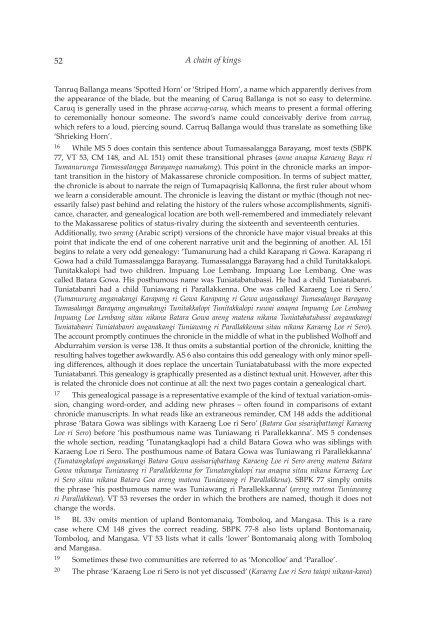A CHAIN OF KINGS - Books and Journals
A CHAIN OF KINGS - Books and Journals
A CHAIN OF KINGS - Books and Journals
Create successful ePaper yourself
Turn your PDF publications into a flip-book with our unique Google optimized e-Paper software.
52<br />
A chain of kings<br />
Tanruq Ballanga means ‘Spotted Horn’ or ‘Striped Horn’, a name which apparently derives from<br />
the appearance of the blade, but the meaning of Caruq Ballanga is not so easy to determine.<br />
Caruq is generally used in the phrase accaruq-caruq, which means to present a formal offering<br />
to ceremonially honour someone. The sword’s name could conceivably derive from carruq,<br />
which refers to a loud, piercing sound. Carruq Ballanga would thus translate as something like<br />
‘Shrieking Horn’.<br />
16 While MS 5 does contain this sentence about Tumassalangga Barayang, most texts (SBPK<br />
77, VT 53, CM 148, <strong>and</strong> AL 151) omit these transitional phrases (anne anaqna Karaeng Bayu ri<br />
Tumanurunga Tumassalangga Barayanga naanakang). This point in the chronicle marks an important<br />
transition in the history of Makassarese chronicle composition. In terms of subject matter,<br />
the chronicle is about to narrate the reign of Tumapaqrisiq Kallonna, the first ruler about whom<br />
we learn a considerable amount. The chronicle is leaving the distant or mythic (though not necessarily<br />
false) past behind <strong>and</strong> relating the history of the rulers whose accomplishments, significance,<br />
character, <strong>and</strong> genealogical location are both well-remembered <strong>and</strong> immediately relevant<br />
to the Makassarese politics of status-rivalry during the sixteenth <strong>and</strong> seventeenth centuries.<br />
Additionally, two serang (Arabic script) versions of the chronicle have major visual breaks at this<br />
point that indicate the end of one coherent narrative unit <strong>and</strong> the beginning of another. AL 151<br />
begins to relate a very odd genealogy: ‘Tumanurung had a child Karapang ri Gowa. Karapang ri<br />
Gowa had a child Tumassalangga Barayang. Tumassalangga Barayang had a child Tunitakkalopi.<br />
Tunitakkalopi had two children. Impuang Loe Lembang. Impuang Loe Lembang. One was<br />
called Batara Gowa. His posthumous name was Tuniatabatubassi. He had a child Tuniatabanri.<br />
Tuniatabanri had a child Tuniawang ri Parallakkenna. One was called Karaeng Loe ri Sero.’<br />
(Tumanurung anganakangi Karapang ri Gowa Karapang ri Gowa anganakangi Tumasalanga Barayang<br />
Tumasalanga Barayang anganakangi Tunitakkalopi Tunitakkalopi ruwai anaqna Impuang Loe Lembang<br />
Impuang Loe Lembang sitau nikana Batara Gowa areng matena nikana Tuniatabatubassi anganakangi<br />
Tuniatabanri Tuniatabanri anganakangi Tuniawang ri Parallakkenna sitau nikana Karaeng Loe ri Sero).<br />
The account promptly continues the chronicle in the middle of what in the published Wolhoff <strong>and</strong><br />
Abdurrahim version is verse 138. It thus omits a substantial portion of the chronicle, knitting the<br />
resulting halves together awkwardly. AS 6 also contains this odd genealogy with only minor spelling<br />
differences, although it does replace the uncertain Tuniatabatubassi with the more expected<br />
Tuniatabanri. This genealogy is graphically presented as a distinct textual unit. However, after this<br />
is related the chronicle does not continue at all: the next two pages contain a genealogical chart.<br />
17 This genealogical passage is a representative example of the kind of textual variation-omission,<br />
changing word-order, <strong>and</strong> adding new phrases ‒ often found in comparisons of extant<br />
chronicle manuscripts. In what reads like an extraneous reminder, CM 148 adds the additional<br />
phrase ‘Batara Gowa was siblings with Karaeng Loe ri Sero’ (Batara Goa sisariqbattangi Karaeng<br />
Loe ri Sero) before ‘his posthumous name was Tuniawang ri Parallekkanna’. MS 5 condenses<br />
the whole section, reading ‘Tunatangkaqlopi had a child Batara Gowa who was siblings with<br />
Karaeng Loe ri Sero. The posthumous name of Batara Gowa was Tuniawang ri Parallekkanna’<br />
(Tunatangkalopi anganakangi Batara Gowa assisariqbattang Karaeng Loe ri Sero areng matena Batara<br />
Gowa nikanaya Tuniawang ri Parallakkenna for Tunatangkalopi rua anaqna sitau nikana Karaeng Loe<br />
ri Sero sitau nikana Batara Goa areng matena Tuniawang ri Parallakkena). SBPK 77 simply omits<br />
the phrase ‘his posthumous name was Tuniawang ri Parallekkanna’ (areng matena Tuniawang<br />
ri Parallakkena). VT 53 reverses the order in which the brothers are named, though it does not<br />
change the words.<br />
18 BL 33v omits mention of upl<strong>and</strong> Bontomanaiq, Tomboloq, <strong>and</strong> Mangasa. This is a rare<br />
case where CM 148 gives the correct reading. SBPK 77-8 also lists upl<strong>and</strong> Bontomanaiq,<br />
Tomboloq, <strong>and</strong> Mangasa. VT 53 lists what it calls ‘lower’ Bontomanaiq along with Tomboloq<br />
<strong>and</strong> Mangasa.<br />
19 Sometimes these two communities are referred to as ‘Moncolloe’ <strong>and</strong> ‘Paralloe’.<br />
20 The phrase ‘Karaeng Loe ri Sero is not yet discussed’ (Karaeng Loe ri Sero taiapi nikana-kana)









![Am HaSefer [Volk des Buches] - Books and Journals](https://img.yumpu.com/20648352/1/174x260/am-hasefer-volk-des-buches-books-and-journals.jpg?quality=85)







